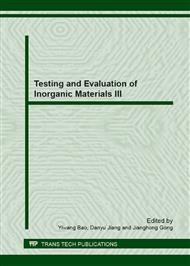[1]
O.L. Ighodaro, O.I. Okoli, Fracture toughness enhancement for alumina systems: a review, Int. J. Appl. Ceram. Technol. 5 (2008) 313-323.
DOI: 10.1111/j.1744-7402.2008.02224.x
Google Scholar
[2]
Y.L. Li, H.E. Kim, Y.H. Koh, Improving the surface hardness of zirconia toughened alumina (ZTA) composites by surface treatment with a boehmite sol, Ceram. Int. 38 (2012) 2889-2892.
DOI: 10.1016/j.ceramint.2011.11.062
Google Scholar
[3]
I. Ganesh, S.M. Olhero, P.M.C. Torres, F.J. Alves, J.M.F. Ferreira, Hydrolysis-induced aqueous gelcasting for near-net shape forming of ZTA ceramic composites, J. Eur. Ceram. Soc. 29 (2009) 1393-1401.
DOI: 10.1016/j.jeurceramsoc.2008.08.033
Google Scholar
[4]
C. Zhang, T. Qiu, J. Yang, J. Guo, The effect of solid volume fraction on properties of ZTA composites by gelcasting using DMAA system, Mater. Sci. Eng., A 539 (2012) 243-249.
DOI: 10.1016/j.msea.2012.01.090
Google Scholar
[5]
A. Nevarez-Rascon, A. Aguilar-Elguezabal, E. Orrantia, M.H. Bocanegra-Bernal, On the wide range of mechanical properties of ZTA and ATZ based dental ceramic composites by varying the Al2O3 and ZrO2 content, Int. J. Refract. Met. Hard Mater. 27 (2009).
DOI: 10.1016/j.ijrmhm.2009.06.001
Google Scholar
[6]
W.H. Tuan, R.Z. Chen, T.C. Wang, C.H. Cheng, P.S. Kuo, Mechanical properties of Al2O3/ZrO2 composites, J. Eur. Ceram. Soc. 22 (2002) 2827-2833.
DOI: 10.1016/s0955-2219(02)00043-2
Google Scholar
[7]
A. Rafferty, A.M. Alsebaie, A.G. Olabi, T. Prescott, Properties of zirconiatoughened-alumina prepared via powder processing and colloidal processing routes, J. Colloid Interface Sci. 329 (2009) 310-315.
DOI: 10.1016/j.jcis.2008.10.010
Google Scholar
[8]
A.K. Dey, K. Biswas, Dry sliding wear of zirconia-toughened alumina with different metal oxide additives, Ceram. Int. 35 (2009) 997-1002.
DOI: 10.1016/j.ceramint.2008.04.006
Google Scholar
[9]
G. Magnania, A. Brillante, Effect of the composition and sintering process on mechanical properties and residual stresses in zirconia–alumina composites, J. Eur. Ceram. Soc. 25 (2005) 383-3392.
DOI: 10.1016/j.jeurceramsoc.2004.09.025
Google Scholar
[10]
X. Wang, J.T. Tian, X.G. Yu, Y. Shan, Z.F. Liu, Y.S. Yin, Effect of microstructure on the fracture behavior of micro-nano ZTA composite, Mater. Chem. Phys. 112 (2008) 213-217.
DOI: 10.1016/j.matchemphys.2008.05.041
Google Scholar
[11]
D. Casellas, M.M. Nagl, L. Llanes, M. Anglada, Fracture toughness of alumina and ZTA ceramics: microstructural coarsening effects, J. Mater. Proc. Technol. 143 (2003) 148-152.
DOI: 10.1016/s0924-0136(03)00396-0
Google Scholar
[12]
X.W. Huang, S.W. Wang, X.X. Huang, Microstructure and mechanical properties of ZTA fabricated by liquid phase sintering, Int. Ceram. 29 (2003) 765-769.
DOI: 10.1016/s0272-8842(02)00228-6
Google Scholar


